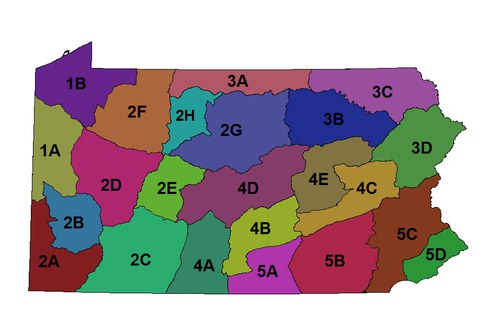As with all things in life, everything is relative. Depending on your perspective, bigger can be better. It is no secret that I love cake. For me, the bigger the cake, the better.
But then there is my backside. I’d prefer my backside not be bigger. And so it goes. Bigger bank account, cafe lattes, Christmas trees = better. Bigger cell phones, laundry piles, backsides = not better.
When it comes to deer management, there has long been a debate on the size of the management unit. Pennsylvania transitioned from smaller county-based management units to larger wildlife management units (WMUs) a decade and a half ago. After 16 years, there is still concern over the effectiveness of WMUs.
Here’s how the story goes. Hunters criticize larger game management units because they assume smaller units possess less variation in wildlife populations and more closely represent their local area. But is that really true?
A recent publication by our own Duane Diefenbach and Chris Rosenberry looked at deer harvest variation in both county-based and current wildlife management units. In Pennsylvania, a hunter can use his antlered deer license to harvest a buck anywhere in the state. However, to harvest an antlerless deer, a hunter must possess the appropriate unit license. With larger wildlife management units, those antlerless licenses can be used over a larger area. Hunters believe a disproportionate number of deer were being harvested from in certain areas of larger units.

After all the data were analyzed, there was no support for the assumption that larger management units result in greater spatial variation in deer harvest.
You might think if there is no difference in deer harvest with regard to management unit size then why not have smaller units?
Well, there are other benefits to having larger wildlife management units as opposed to county-based units. Wildlife management units are based on landscape features, land use practices, land ownership, and human density creating units that are more “like” themselves then their neighbor.
Another big plus is visible, recognizable boundaries. I have yet to see a county line marked in the forest.
Perhaps the biggest upside to the wildlife management unit system is data collection. Reliable data must be collected regardless of management unit size to properly manage deer. There are several choices for gathering these data.
First, you could divide the state into a large number of small units. But not enough data can be collected to support management recommendations. There is high variability in measures leading to a reduction in accuracy.
Second, you could divide the state into a large number of small units but group the small units into larger units for management purposes. There would be sufficient data to support management recommendations, but this treats unlike units equally.
Or you could create fewer, larger management units that provide enough dependable data to adequately support recommendations and treat each management unit separately.
Call me crazy but that seems like the best option to me.
The debate about management unit size will likely continue in perpetuity because hunters don’t hunt the entirety of say WMU 2C. They hunt a few hundred acres. It’s about scale and perspective. The Game Commission or any wildlife agency cannot manage deer at that scale and hunters cannot see beyond their perspective. This is not the fault of either party.
This size issue can be seen in other areas of life. For examples, PennDOT snow plowing is based on area, road network, equipment, traffic density, and likely a dozen other factors. They manage based on their resources, but if the roads I am traveling are not cleared, I wonder if they are doing anything at all!
Such is the circumstance of life – doing the best you can with what you got. Now where’s the BIG cake?
And Follow us on Twitter @WTDresearch
